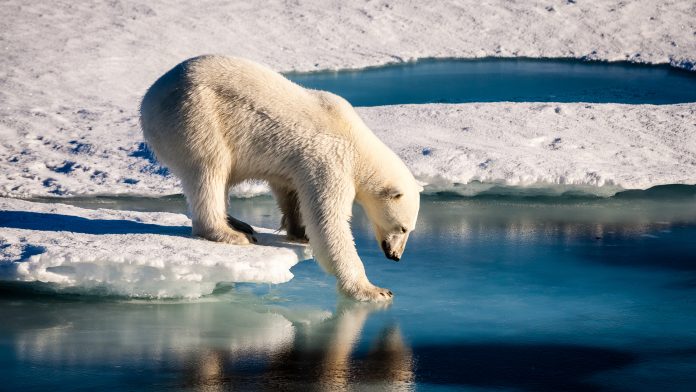Due to ever-increasing climate change impacts causing sea ice to melt, polar bears are being forced to travel longer and more hazardous distances to obtain food.
In recent years, polar bears in the Beaufort Sea have had no choice but to travel far outside of their traditional arctic hunting grounds to acquire food due to the melting ice caps. This has devastatingly contributed to an almost 30% decrease in their population.
According to a recent study in the journal Ecosphere, the amount of space polar bear’s need for food and other resources, otherwise known as the polar bear’s home range, was around 64% larger from 1999-2016 than it was in 1986-1998.
“Having to travel farther means these bears are expending more energy which can threaten their survival,” explained Anthony Pagano, a postdoctoral researcher in Washington State University’s School of the Environment and lead author of the study. “If we want to preserve the habitat of these amazing mammals, then we need to focus on the root of the problem, which is slowing global climate change.”
For the study, Pagano and colleagues from the US Geological Survey utilised satellite tracking data in order to analyse the movement patterns of female polar bears from 1986-2016 in the Beaufort Sea area north of Alaska.
The continental shelf
Their work demonstrated that over the last two decades, polar bears are being forced to travel farther north of their traditional hunting grounds on the continental shelf to remain on their receding sea ice habitat. Extending around 100 miles north of Alaska and Canada, the continental shelf is a shallow water habitat that contains plenty of fish for the bears’ favourite prey, seals.
During the early summer when seals are most vulnerable to attack due to weaning their pups, polar bears will often double their body weight from eating their fatty meat.
The researchers’ data indicates that as the sea ice over the continental shelf continues to recede at a quicker pace and over a larger surface area; the bears are being displaced from this primary foraging habitat and traveling further north into deeper waters where there are fewer seals to prey on.
“The combined impact of having to move farther and farther north with the ice in the summer and then having to move back in the fall and winter as the ice freezes is taking a major toll,” Pagano said.
Polar bear’s search for alternative food sources
Another interesting finding of the study is that around 20% of the polar bear population in the Beaufort Sea is foregoing their traditional sea ice hunting grounds altogether in the summer and autumn seasons. These bears are moving inland along the Alaskan and Canadian coast looking for food such as carrion, berries and sometimes even bowhead whale carcasses that are left on the shore by indigenous residents that hunt the large aquatic mammals.
“Sometimes you’ll have 50 to 100 polar bears that congregate around these whale carcasses and compete with each other for food,” Pagano said. “As more and more bears move on land, I suspect there’ll be a lot more competition for these food resources and we’ll probably start seeing further decreases in abundance and survival.”
The results- the need to reduce global carbon emissions
Moving forward, Pagano and his colleagues with the US Geological Survey intend to conduct further studies of the polar bears traveling inland to gain a better idea of how they are coping with their new terrestrial habitat.
He stated that the best thing humans can do to help preserve the southern Beaufort Sea’s estimated 800 remaining polar bears, is to focus on curbing global carbon emissions which are the main cause behind receding arctic sea ice.
Recent modelling work has revealed that if regulations are enacted to reduce these emissions to avoid global warming greater than 2°C or 3.6°F, then it could drastically slow the decline of polar bear habitats in the arctic, which would in turn help these animals to survive.
“Coming across a polar bear while flying over the arctic in a helicopter is a surreal experience,” Pagano concluded. “They are incredibly massive and impressive. It is amazing to observe this animal that is so uniquely adapted to exist in this harsh arctic environment. They are worth the effort it will take to preserve them.”









